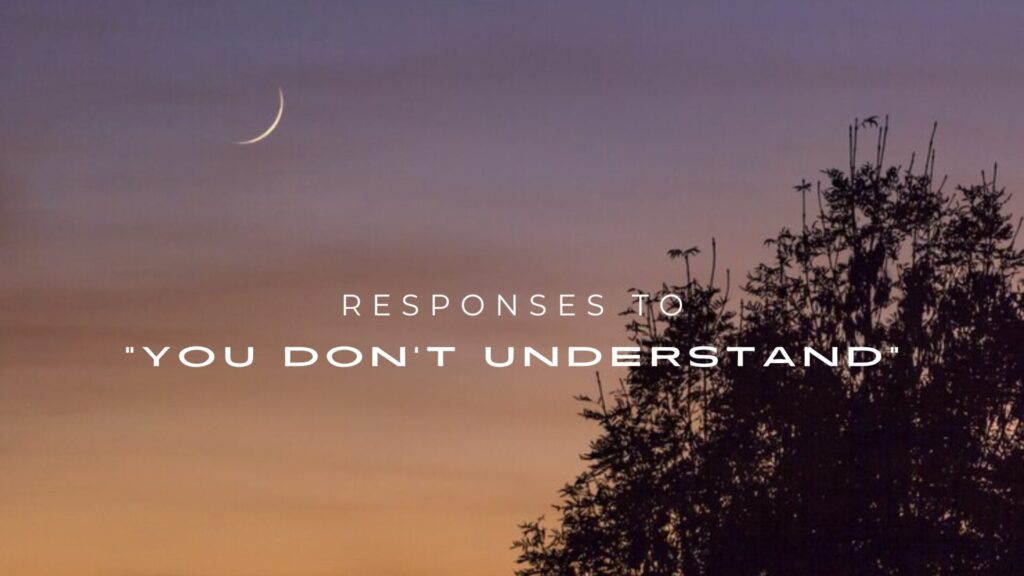Have you ever been in a conversation where someone blurts out, “You don’t understand”? It’s a phrase that can sting and create a wall between you and the other person. But don’t worry; responding thoughtfully can turn things around and strengthen your relationship. Let’s dive into why people say this and how you can respond in a way that shows empathy and understanding.
Why People Say “You Don’t Understand”
When someone says, “You don’t understand,” it’s often more than a statement. It’s an emotional outburst rooted in frustration, a cry for validation, or a sign of isolation. Let’s break this down a bit:
- Emotional Outburst: Sometimes, emotions run high, and this phrase is a way to release pent-up feelings.
- Seeking Validation: People might feel their experiences or feelings are not acknowledged.
- Feeling Isolated: They could feel alone and believe no one else can relate.

200+ Responses to “You Don’t Understand”
Empathetic Responses
- I’m sorry you feel that way. I want to understand your point of view.
- It sounds like you’re frustrated. Can we take a moment to talk it through?
- I hear you. Let’s work together to ensure I understand where you’re coming from.
- I can tell this is important to you. Help me understand better so I can support you.
- I apologize if I’m missing something. I’m here to listen and understand.
- This might not be coming across as I intend. Let’s dive into it a bit more.
- Your feelings are valid, and I want to understand them fully.
- I’m here for you and want to understand your perspective more clearly.
- I appreciate your patience. Let’s go over it again so I can get it right.
- I know this is important to you. Let’s talk through it so we’re on the same page.
Clarification Responses
- Can you tell me which part I’m not understanding? I want to get it right.
- What specific aspect of this is confusing for me? I’m here to listen and learn.
- Please explain that point. I want to make sure I understand you correctly.
- I’m not quite following. Can you give me more details on what you mean?
- Which part of my response didn’t make sense to you? Let’s clear that up.
- Help me out here—what exactly am I missing? I want to get a clear picture.
- I need more information to grasp your point. Can you elaborate on that?
- Can you break it down for me? I want to understand each part better.
- What do you think I’m misunderstanding? Let’s address it together.
- Could you provide an example or explain it differently? I’m trying to get it.
Defensive Responses
- I think I understand, but maybe we’re just seeing this differently.
- I’ve been trying to get it, but maybe we’re not on the same wavelength.
- I do understand, though it seems we’re not quite aligned.
- I’m doing my best to understand your perspective. Maybe we just need to clarify a bit.
- I think I get what you’re saying, but we might be interpreting things in different ways.
- I believe I’m following, but let’s see if we approach this from the same angle.
- I’m confident I’m grasping the basics. Perhaps there’s a different way to look at it.
- I’m not sure I agree that I don’t understand. Let’s discuss what might be missing.
- I think we’re just having a communication gap. I’m trying to get what you mean.
- I understand your point, but we’re having a bit of a miscommunication.
Concessive Responses
- You’re right; I might not fully get it yet. Let’s talk more so I can catch up.
- I may be missing some details. Help me out so I can understand better.
- It’s possible that I don’t have the whole picture. Can we explore it further together?
- I may not have grasped everything. Let’s work through it together.
- You’re probably right; I don’t have all the facts yet. I’m open to learning more.
- I understand that I might not be fully there. Please explain a bit more so I can get it.
- I agree; I might be missing some nuances. Let’s dive deeper so I can better understand.
- It seems I don’t have the complete picture yet. Can you help fill in the gaps?
- I’m aware that I might not fully understand. I’d appreciate your help in clarifying it.
- I may not be on the same page. Let’s work through this so I can understand better.
Reflective Responses
- It sounds like this is important to you. Let’s reflect on what might be causing the disconnect.
- I hear you. Let’s take a moment to reflect on what could be causing my misunderstanding.
- I’m thinking about what you’ve said. What can we do to bridge the gap in understanding?
- Let’s step back and reflect on the key points to see where we might be missing each other.
- I’m reflecting on our conversation. Can you help me pinpoint where I might be off track?
- Let’s pause and think about what might be confusing. I want to get this right.
- I’m considering your feedback. What specific aspects should we focus on to clear things up?
- Reflecting on this, I might be missing something. Let’s explore it further.
- I’m processing what you’re saying. How can we better align our understanding?
- I’m reflecting on your perspective. What can I do to improve my understanding of your point?
Reassuring Responses
- I’m here to listen and understand. We’ll work through this together.
- I want you to know that your perspective matters to me. Let’s make sure I get it right.
- I’m committed to understanding your viewpoint. We’ll find a way to get on the same page.
- Don’t worry, I’m here to support you. Let’s keep talking until I fully understand.
- I’m dedicated to getting this right. Your input is important, and I’m ready to listen.
- You’re not alone in this. I’m here to understand, and we’ll get there together.
- I’m focused on understanding your side of things. We’ll work through any confusion together.
- You can count on me to keep trying until I understand. Your perspective is important.
- I’m here for you, and I’ll keep working at it until I grasp your point completely.
- Let’s take our time with this. I’m committed to understanding and finding clarity together.
Neutral Responses
- Alright, let’s go over it again. I want to make sure I understand.
- Okay, let’s discuss this a bit more to clarify things.
- I see. Let’s revisit this topic and see if we can clarify things.
- I got it. Let’s break it down further to ensure we’re on the same page.
- Understood. Can we go through the details again?
- Let’s review the key points to ensure I’m following along.
- I hear you. Let’s take another look at this to clear up any confusion.
- Okay, let’s examine this a bit more closely to get a better understanding.
- I understand. Let’s work through this step by step.
- Noted. Let’s go over it again to make sure everything is clear.
Supportive Responses
- I’m here to help you. Let’s work through this together until I understand.
- You’ve got my full attention. How can I support you in getting this across?
- I’m ready to listen and learn. What can I do to understand your perspective better?
- Let’s tackle this together. I’m here to support you and make sure I get it right.
- I want to be as helpful as possible. How can I assist you in explaining this?
- I’m on your side. Let’s find a way to clear up any misunderstandings.
- I’m here to support you through this. Let’s work on getting it straightened out.
- Your input is valuable. How can I best support you in communicating this?
- I’m committed to understanding. Let’s collaborate to ensure we’re on the same page.
- I’m here to help you with this. Let’s figure out a way to bridge any gaps in understanding.
Inquisitive Responses
- Can you tell me more about what you mean? I want to understand your perspective better.
- What specific part of this do you think I’m not getting? Let’s dig into it.
- Please give me an example or elaborate on that.
- What aspect of this is unclear to me? Help me understand it better.
- Can you walk me through this in more detail? I want to grasp it fully.
- What are the main points I might be missing? I want to get a clearer picture.
- Is there a particular part of this that’s confusing? Let’s address it.
- Please explain that. I’m trying to understand where I’m off track.
- What should I focus on to better understand your point? Help me get it right.
- Could you clarify what’s important here? I want to make sure I’m following you correctly.
Acknowledging Responses
- I see that you feel I’m not getting it. Let’s take a closer look at this together.
- I understand that you feel misunderstood. I want to acknowledge that and work through it.
- It sounds like there’s something important I’m missing. Let’s address that directly.
- I hear you. I may not fully grasp your point yet.
- I get that you feel I’m not understanding. Let’s explore this further to clarify things.
- I recognize that there’s a gap in my understanding. Can we fill that in together?
- I see where I might need to catch up. Let’s discuss this so I can better understand your perspective.
- I understand your frustration. Let’s work on pinpointing where I’m not following.
- I acknowledge that I may not fully understand. I’m here to listen and learn more.
- This is important to you, and I might need to grasp it fully. Let’s clarify it.
Contradictory Responses
- I understand, but maybe we’re just interpreting things differently.
- I understand what you’re saying, even if we might see it from different angles.
- I’m not entirely sure I agree that I don’t understand. Could we explore this further?
- I believe I understand the main points, though it seems like there’s a misunderstanding.
- I’m following your perspective, but perhaps we’re not aligning perfectly on the details.
- I understand your view, but we might have different interpretations.
- I’m pretty sure I grasp the basics, but we’re not quite on the same page.
- I feel like I’m getting it, but let’s see if we can reconcile our viewpoints.
- I understand where you’re coming from, though we might miss each other slightly.
- I understand the core idea, but we need to clarify a detail.
Collaborative Responses
- Let’s work on this together to bridge the gap in understanding. What can we do to clarify it?
- Let’s figure this out as a team. I’m sure we can get on the same page.
- Let’s collaborate on this to ensure we both understand each other clearly.
- We can tackle this together. What’s the best way to clarify this misunderstanding?
- Let’s combine our efforts to work through this. I’m sure we can reach a mutual understanding.
- How can we team up to solve this communication issue? I’m here to work through it with you.
- Let’s approach this as a joint effort. How can we make sure we both understand each other?
- We can solve this together. What steps can we take to improve our understanding?
- Let’s join forces to clear up any confusion. I’m eager to work this out with you.
- How can we collaborate to address this? I’m committed to understanding and resolving it together.
Apologetic Responses
- I’m sorry if I’m not getting it. I appreciate your patience and want to understand better.
- I apologize if I seem out of touch. Please help me grasp your point more clearly.
- I’m sorry if I’ve misunderstood. Let’s work together to get this right.
- My apologies if I’m missing something important. I’m here to listen and learn more.
- I’m sorry if my understanding isn’t quite there. I want to correct that and get it right.
- I regret if I’m not fully grasping your perspective. Please guide me so I can better understand.
- I’m sorry if I’m not on the same page. Let’s go over it again so I can get it right.
- I apologize if my response wasn’t clear. I’m committed to understanding your point of view.
- I’m sorry if I’m not following along. Your patience means a lot, and I want to improve my understanding.
- I apologize if I’m not fully understanding. Let’s discuss it further so I can get a clearer picture.
Encouraging Responses
- You’re doing great in explaining this. Keep going, and let’s work through it together.
- I appreciate your effort in clarifying. Let’s keep at it until we’re both clear on this.
- Your input is really valuable. Let’s continue working through this until I get it.
- This might be challenging, but I’m here to support you. Let’s get this figured out together.
- You’re making good points. Let’s keep the conversation going to ensure I fully understand.
- I’m glad you’re sharing this with me. Let’s keep talking so I can get a better grasp of it.
- Your explanation is helpful. Let’s continue this discussion to clear up any confusion.
- You’re doing well in helping me understand. Let’s keep working on it until we get there.
- Thanks for being patient. I’m here to understand, so let’s keep working on this together.
- You’re making good progress. Let’s keep the dialogue open so I can understand more clearly.
Reflective Listening Responses
- You’re feeling frustrated because I’m not quite getting it. Can you tell me more about that?
- I hear that you’re feeling misunderstood. Let’s explore what I might be missing here.
- From what you’re saying, there’s a gap in my understanding. Can you help me fill it?
- I’m getting that this is important to you. Can you elaborate on what I’m not catching?
- It sounds like you’re struggling to get your point across. Let’s reflect on where I might be going wrong.
- I’m hearing that there’s a disconnect. Can you describe more about where I’m missing the mark?
- It seems like I’m not following you completely. Let’s dive into the specifics to bridge this gap.
- I’m sensing that my understanding isn’t aligning with yours. Can we break it down a bit more?
- It sounds like I’m not quite there yet. What part of this should we focus on to improve my understanding?
- I’m hearing you express frustration with my grasp of this. Let’s reflect on the details to see where I might be off.
Receptive Responses
- I’m open to hearing more about this. Please share more details so I can get it.
- I’m ready to listen. Let’s go over this again so I can better understand your perspective.
- I’m all ears. Tell me more about what I’m not grasping.
- I’m receptive to your explanation. How can I improve my understanding?
- I’m here to listen and learn. Let’s talk through this so I can follow along better.
- I want to hear everything you have to say. Can you explain it in more detail?
- I’m eager to understand. Please help me see where I’m going wrong.
- I’m open to any insights you can offer. Let’s work together to clear this up.
- I’m ready to hear your perspective. What can I do to get a better grasp on this?
- I’m listening closely. Help me understand the details I might be missing.
Instructional Responses
- Can you walk me through this step by step? I want to understand each part.
- Please break this down into simpler terms for me. I’m having trouble following.
- Please guide me through the key points. What should I focus on to get this right?
- Can you show me an example or provide a scenario to illustrate your point?
- Let’s go through this together. What’s the best way to explain it to ensure I understand?
- Could you outline the main ideas again? I want to make sure I’m on the right track.
- Can you give me a detailed explanation of the parts I’m not getting?
- Help me by providing a clear breakdown of what you mean. I’d like to understand each aspect.
- Could you walk me through the process or concept? I’m struggling to see the details.
- Let’s review this step by step. What’s the most effective way to explain this to me?
Open-Ended Responses
- What would help you feel more understood? Let’s figure that out together.
- How can we approach this differently so I can better grasp your point?
- What is the main issue in my understanding? Let’s explore it.
- What more can you share to help me understand this better?
- What aspects of this are you finding most challenging to communicate? Let’s address those.
- How can we adjust our conversation to make sure I understand your perspective?
- What additional information might help clarify things for me?
- What’s the best way for us to tackle this misunderstanding? I’m open to suggestions.
- How can we ensure we’re both on the same page moving forward?
- How can I improve my understanding of what you’re trying to convey?
Acknowledgment of Feelings Responses
- This is important to you, and you’re frustrated. Let’s work through it together.
- I understand that you’re feeling upset because I’m not getting it. Your feelings are valid, and I want to address this.
- This is a significant issue for you. I recognize your feelings and want to make sure I understand.
- I hear you’re feeling misunderstood, and I’m sorry. Let’s find a way to clear up the confusion.
- I get that this situation is frustrating for you. I’m here to listen and better understand how you’re feeling.
- I can sense your frustration with my lack of understanding. Your feelings are important, and I want to address this.
- I recognize that you’re feeling upset. Let’s take a step to address how I can better understand your point of view.
- I understand that this is a sensitive topic for you. I want to acknowledge how you’re feeling and work through it.
- I hear that you’re feeling overwhelmed by this misunderstanding. Your feelings matter, and I want to improve my understanding.
- I can see that this issue is causing you some stress. I’m here to acknowledge that and work together to resolve it.
Action-Oriented Responses
- Let’s take some specific steps to clear this up. What can we do right now to improve my understanding?
- Let’s outline the main points and review them together. This might help me get it better.
- I suggest we summarize what we’ve discussed so far. What key points should we focus on to clear up the confusion?
- Can we create a list of things I might be missing? We can go through each item to ensure I understand.
- Let’s set up a plan to revisit this topic. What actions should we take to address the gaps in my understanding?
- How about we document the main ideas and revisit them later? This way, I can review and understand better.
- Let’s break this down into manageable steps. What specific actions can we take to improve clarity?
- Let’s schedule a follow-up conversation to review this. What additional resources or explanations can we use?
- Let’s identify the key areas where my understanding is lacking. What actions can we take to address these gaps?
- How can we structure our discussion to make it easier for me to understand? What specific steps should we take?
Initial Reaction: Stay Calm
Your first instinct might be to defend yourself or argue back, but staying calm is crucial. Take a deep breath and focus on maintaining your composure. This helps you think clearly and sets a positive tone for the conversation.
- Active Listening: Show that you’re genuinely interested in what they’re saying. Nodding and maintaining eye contact goes a long way.
Validating Their Feelings
One of the best ways to respond is by validating their feelings. This doesn’t mean you must agree with everything they say, but acknowledge their emotions.
- Expressing Empathy: Phrases like, “I can see why you feel that way,” or “It sounds like this is really tough for you,” can be very comforting.
- Using Reflective Statements: Repeat what they’ve said in your own words to show you’re listening, like “So you’re saying that…”
Asking Clarifying Questions
Sometimes, asking questions is the best way to show you’re trying to understand. This shows you care about getting the full picture.
- Importance of Clarity: Ask open-ended questions that encourage them to share more. For example, “Can you tell me more about what’s been going on?”
- Examples of Clarifying Questions: “What happened that made you feel this way?” or “How does this situation affect you?”
Sharing Personal Experiences
There’s a fine line between sharing your experiences to relate and overshadowing their feelings. Use your judgment here.
- When to Share Your Story: If you’ve had a similar experience, sharing it briefly can help you feel less alone. Just be sure not to make it all about you.
- Balancing Empathy and Experience: Keep it relevant and concise, ensuring the focus remains on their feelings.
Offering Support
Showing that you’re there for them can make a huge difference.
- Verbal Reassurance: Simple statements like, “I’m here for you,” or “Let me know how I can help,” can be very comforting.
- Non-Verbal Cues: A gentle touch on the arm or a reassuring smile can also convey support.
Avoiding Common Pitfalls
You should avoid a few things when someone says, “You don’t understand.”
- Minimizing Their Feelings: Phrases like “It’s not a big deal,” or “You’re overreacting,” can be very hurtful.
- Offering Unsolicited Advice: Sometimes people want to be heard, not fixed. Wait for them to ask for your opinion before offering advice.
Using Positive Language
The words you choose can significantly impact the conversation’s outcome.
- Encouraging Words: Use language that uplifts and encourages. For instance, “I believe in you,” or “You’re doing great.”
- Avoiding Negative Phrasing: Clear negative terms that might make them feel worse.
Acknowledging Differences
Recognize and respect that everyone’s experiences and perspectives are different.
- Respecting Individual Perspectives: Understand that their unique experiences shape their viewpoint.
- Celebrating Diversity: Appreciate the differences and see them as opportunities to learn and grow.
When Silence is Golden
Sometimes, the best response is no response at all.
- The Power of Silence: A moment can give them the space to gather their thoughts and continue sharing.
- Knowing When to Speak: Silence can also show you’re truly listening and not rushing to reply.
Revisiting the Conversation Later
If the moment doesn’t feel right, revisiting the conversation later is okay.
- Importance of Follow-Up: Check in with them after some time to show you’re still thinking about them.
- Maintaining Open Communication: Keep the lines of communication open and let them know they can talk to you anytime.
Building Stronger Connections
Responding thoughtfully to “You don’t understand” can strengthen your relationship.
- Strengthening Relationships Through Understanding: Showing empathy and care can deepen your bond.
- The Role of Trust: Trust is built when people feel heard and understood.
The Impact of a Thoughtful Response
Your response can have a lasting impact on both your relationship and your personal growth.
- Long-Term Effects on Relationships: Thoughtful responses foster stronger, more meaningful connections.
- Personal Growth: Practicing empathy and understanding can make you a better friend, partner, or family member.
Conclusion
In navigating conversations where someone says, “You don’t understand,” it’s essential to approach the situation with empathy and patience. You validate their feelings and foster a more productive dialogue by choosing thoughtful and respectful responses. Whether you’re aiming to bridge a gap or acknowledge their perspective, having a variety of responses at your disposal can make all the difference.
For further guidance on managing delicate interactions, you might find our article on:
Handle “You Have An Attitude” Comments: 200+ Replies
FAQs
Q. How can I improve my empathetic listening skills?
Practice active listening, avoid interrupting, and show genuine interest in what the other person is saying. Reflect on their words and validate their feelings.
Q. What if the person doesn’t want to talk?
Respect their space. Let them know you’re there for them whenever they’re ready to talk. Sometimes, just being present is enough.
Q. How do I deal with my own emotions in these situations?
Take deep breaths and try to stay calm. If you’re feeling overwhelmed, taking a step back and revisiting the conversation later is okay.
Q. Is it ever okay to disagree with someone saying, “You don’t understand”?
Yes, but do so respectfully. Acknowledge their feelings first, then gently share your perspective without invalidating theirs.
Q. Can professional help be sought if the issue persists?
Absolutely. Sometimes, seeking help from a therapist or counselor can provide valuable support and guidance for both parties.











Amazing Content! If you need some details about about Airport Transfer than have a look here 57N